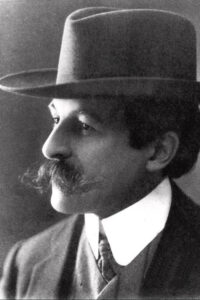
The Golden Triangle The Return of Arsène Lupin
Not a word was uttered among them. None of the seven crippled soldiers seemed to know his companions or to trouble about or even perceive their presence. They stood behind their trees behind the kiosk or the group of Silenus figures without stirring. And the few wanderers who, on that evening of the 3rd of April, 1915, crossed this unfrequented square, which received hardly any light from the shrouded street lamps, did not slacken pace to observe the men’s motionless outlines.
A clock struck half-past six. At that moment, the door of one of the houses overlooking the square opened. A man came out, closed the door behind him, crossed the Rue de Chaillot, and walked around the open space before the museum. It was an officer in khaki. Under his red forage cap, with its three lines of gold braid, his head was wrapped in a wide linen bandage, which hid his forehead and neck. He was tall and very slenderly built. His right leg ended in a wooden stump with a rubber foot to it. He leaned on a stick.
Leaving the square, he stepped into the roadway of the Rue Pierre-Charron. Here, he turned and looked leisurely to his surroundings on every side. This minute inspection brought him to one of the trees facing the museum. With the tip of his cane, he gently tapped a protruding stomach. The stomach pulled itself in.
The officer moved off again. This time, he went down the Rue Pierre-Charron to the centre of Paris. He thus came to the Avenue des Champs-Élysées, which he went up, taking the left pavement.
Two hundred yards further on was a large house, which had been transformed, as a flag proclaimed, into a hospital. The officer took up his position at some distance so as not to be seen by those leaving and waited.
It struck a quarter to seven and seven o’clock. A few more minutes passed. Five persons came out of the house, followed by two more. At last, a lady appeared in the hall, a nurse wearing a wide blue cloak marked with the Red Cross.
“Here she comes,” said the officer.
She took the road by which he had arrived and turned down the Rue Pierre-Charron, keeping to the right-hand pavement and thus making for the space where the street meets the Rue de Chaillot. Her walk was light, her step easy and well-balanced.
Read or download Book
Maurice Leblanc
Maurice Marie Émile Leblanc (11 December 1864 – 6 November 1941) was a French novelist and writer of short stories. He is best known for creating the fictional gentleman thief and detective Arsène Lupin, who is often described as a French counterpart to Arthur Conan Doyle’s Sherlock Holmes.
Biography.
The first Arsène Lupin story appeared in a series of short stories that was serialized in the magazine Je sais tout, starting in No. 6, dated 15 July 1905. Created at editorial request, Leblanc may have also read Octave Mirbeau’s Les 21 jours d’un neurasthénique (1901), which features a gentleman thief named Arthur Lebeau, and he had seen Mirbeau’s comedy Scrupules (1902), whose main character is a gentleman thief.
By 1907, Leblanc had graduated to writing full-length Lupin novels, and the reviews and sales were so good that Leblanc effectively dedicated the rest of his career to working on the Lupin stories. Like Conan Doyle, who often appeared embarrassed or hindered by the success of Sherlock Holmes and seemed to regard his success in crime fiction as a detraction from his more “respectable” literary ambitions, Leblanc also appeared to have resented Lupin’s success. Several times, he tried creating other characters, such as private eye Jim Barnett but eventually merged them with Lupin. He continued to pen Lupin tales well into the 1930s.
Leblanc also wrote two notable science fiction novels: Les Trois Yeux (1919), in which a scientist makes televisual contact with three-eyed Venusians, and Le Formidable Evènement (1920), in which an earthquake creates a new landmass between England and France. Leblanc was awarded the Légion d’Honneur for his services to literature and died in Perpignan in 1941. He was buried in the Montparnasse Cemetery. Georgette Leblanc was his sister.
Life
Maurice Leblanc was the second child of Émile Leblanc, a 34-year-old ship-owner merchant, and of Mathilde Blanche (née Brophy), daughter of rich dyers, aged 21 and was delivered by Achille Flaubert, Gustave Flaubert’s brother. He had an elder sister, Jehanne (born in 1863), and a younger sister, Georgette Leblanc (born in 1869), who, from 1883 until the 1920s, was an actor and star operatic soprano. During the Franco-German War of 1870, his father sent Maurice to Scotland. Upon his return to France, he completed his studies in Rouen. The young Maurice received his first education in a free institution, the Patry Pension. Then, from 1875 to 1882, he completed his secondary studies at the Lycée Corneille. As a teenager, he frequently encountered Gustave Flaubert and Guy de Maupassant.
Refusing the career his father intended for him at a card factory, Maurice headed to Paris in 1888 to pursue writing instead. First a journalist, then a novelist and storyteller. His first novel, “Une femme” (A Woman), published in 1893, was very successful and was followed by other works, such as “Des Couples” (The Couples), “Voici des Ailes” (Here Are Wings) and his only play, “La pitié”, released in 1902, which is a failure, causing him to give up the theatre for a while. In 1901, he published “L’Enthousiasme”, an autobiographical novel.
In 1905, Pierre Lafitte, the director of the monthly Je sais tout, commissioned a short story from Leblanc in the vein of A.J Raffles by Ernest William Hornung and the adventures of Sherlock Holmes. The resulting “L’Arrestation d’Arsène Lupin” (The Arrest of Arsène Lupin) was a great public success. Two years later, the book Arsène Lupin, Gentleman Burglar was released, containing the first nine stories depicting the character published in the French magazine ‘Je sais tout’. The following book, Arsène Lupin versus Herlock Sholmes, a second collection of Arsène Lupin stories written by Maurice Leblanc, angered the Sherlock Holmes creator Conan Doyle, who saw Leblanc’s Herlock Sholmes and Wilson as parody characters designed to ridicule Doyle’s work.
Maurice Leblanc received the Legion of Honor on January 17, 1908, presented by then Under-Secretary of State for Fine Arts, Étienne Dujardin-Beaumetz. While a supporter of French radical socialists and free-thinker in his early age, Leblanc became more bourgeois during the First World War. Leblanc would start to grow weary of writing Arsène Lupin stories. As early as 1910, he tried to kill his hero in the story “813” but would resurrect the character in the novel The Crystal Stopper.






